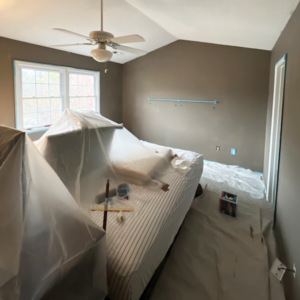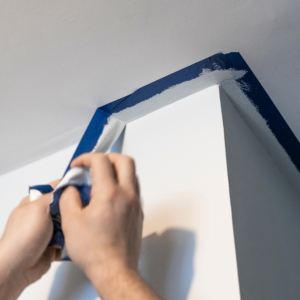
January 10, 2024
Painting a room can be a great way to refresh the look of your home. A fresh coat of paint in the color of the year can rejuvenate your living space and breathe new life into your walls. If you’re tackling this project yourself, you’ll need to know how to paint a room, including the supplies needed, how to prep your space, and the best techniques for a smooth finish.
The first step to any paint job is to calculate how much paint will be needed. Measure the width of each wall and add those numbers together to determine the perimeter. Then measure the height from floor to ceiling. Multiplying these two numbers together will get you the square footage of the walls.
Tip: For a more precise number, make sure to subtract any windows and doors.
Paint cans typically have the number of square feet per gallon listed on the can. If not, a general rule is that one gallon of paint can cover around 350 to 400 square feet. Keep in mind that you’ll probably need more than one coat of paint for full coverage.
Before you start your paint project, there are a few things you should do first to prep your room:

First, remove any furniture or move the furniture to the center of the room and cover with plastic sheeting to avoid paint spills. Make sure to remove any outlet covers, switch plates, or other fixtures that shouldn’t be painted.
Cover the floor with a canvas drop cloth. You can choose a full-size drop cloth for larger paint jobs, or a runner if you’re only painting one wall.
If you have baseboards, windows, doors, cabinets or other surfaces that need to be protected, it’s important to mask them off before you begin painting. Use a high-quality painter’s tape to protect edges. Using a higher quality tape will help ensure a crisp, clean line when you remove the tape.
Choosing the right painter’s tape is essential for achieving professional results. Consider the surface type and project duration. For delicate surfaces, use low-tack painter’s tape, while high-tack tape is better for rough surfaces. Ensure the tape is compatible with your paint type and look for special features like edge-locking technology for sharper lines. By selecting the appropriate painter’s tape, you can ensure a smooth and successful painting project.
Once your floors and edges are protected, it’s time to wash, putty and sand your walls. If your wall has any cracks or holes, use a fast-drying putty for the wall to even the surface. Once it’s dry, sand it down for a smooth appearance.
It’s important to give your walls a once-over with a gentle cleaning solution. This breaks through any built-up dirt or grease. Simply take a clean rag and a bucket with a mild soap or diluted TSP and wipe down the walls. Make sure to let the walls dry completely.
We also recommend quickly sanding down your previously painted walls. Sanding the surface helps ensure your paint will adhere correctly so you won’t be troubled with peeling paint or other issues. After you gently sand the walls with a sanding pole or block, wipe the walls with a damp cloth to remove any dust and let dry. Now you’re ready to paint!

After the second coat has dried, it’s time to clean up. Start by removing the painter’s tape. Gently score the edge of the tape with a utility knife. Peel back an edge of the tape and slowly pull back at a 45-degree angle.
Pull up your floor protection and move your furniture back into place. If you used a drop cloth, clean it before storing it for your next project. Shake it out to get rid of drywall dust and any debris. You can either spot clean it or, if it’s a canvas drop cloth, put it in the washer.
Accidents happen, and even the most seasoned painter can spill paint. If you drop a paint brush or drip paint onto the carpet, here’s how to clean it up.
First, make sure to clean up the excess paint. Gently blot the area with a clean towel but don’t scrub. You’ll risk rubbing the paint further into the carpet fibers.
If you’re using a water- or latex-based paint, use warm water to wet the area and add dish soap. Scrub the area until the stain breaks apart.
If you’re using an oil-based paint, fully saturate the stain and use a carpet cleaner to begin cleaning it. Take a clean towel and use paint remover to dab at the stain until you see it begin to break apart. After the stain is removed, shampoo your carpet to get the paint remover out.
How long should I wait between applying coats of paint?
Follow the drying times recommended on the paint can. Some paint, like oil-based paint, can take a full 24 hours to dry.
Can I use any type of paint for any room?
Consider the room’s function when choosing paint. Matte or flat finishes hide imperfections but are less durable, which makes them unsuitable for high-traffic rooms. Eggshell paints offers a soft sheen and are slightly more durable while satin finishes are easier to clean and are ideal for busy rooms like kitchens and bathrooms.
Is primer necessary, or can I skip this step?
While you can paint without primer, using it ensures better adhesion and a smoother finish. It’s especially beneficial when transitioning between colors or covering stains.
Can I paint over wallpaper?
It’s generally not recommended to paint over wallpaper, as it may lead to adhesion issues. It’s better to remove the wallpaper before painting for a more durable finish.
Take on your painting projects with confidence by following these easy steps. For painting protection needs, Trimaco has you covered. Visit our full catalog for drop cloths, masking paper, painter’s tape and more.
Get Social
1 month ago
Video
Share on Facebook Share on Twitter Share on Linked In Share by Email
1 month ago
Video
Share on Facebook Share on Twitter Share on Linked In Share by Email
1 month ago
Photo
Share on Facebook Share on Twitter Share on Linked In Share by Email
1 month ago
Video
Share on Facebook Share on Twitter Share on Linked In Share by Email
1 month ago
Video
Share on Facebook Share on Twitter Share on Linked In Share by Email
Cling Cover is premium plastic sheeting clings to almost any surface, attracting overspray and keeping your workspace clean, bright, and protected.
2#trimaco #totaljobsiteprotection #savetimesavemoney #work #paint #painting #construction #constructionproducts #build #buildzoom
Prepping for renovation with Easy Mask Tape & Drape 🚨🚨
@refreshhomeimprovements
#trimaco #totaljobsiteprotection #savetimesavemoney #work #paint #painting #construction #constructionproducts #build #buildzoom #building #homebuild
Refresh your kitchen on a budget with an easy DIY backsplash ✨
4Check out our latest blog for a step by step guide: https://trimaco.com/blog/how-to-diy-a-kitchen-backsplash/
#trimaco #totaljobsiteprotection #savetimesavemoney #work #paint #painting #construction #constructionproducts #build #buildzoom
Highly absorbent and reusable, Trimaco’s Wonder Rag is your go-to for a spotless finish
2#trimaco #totaljobsiteprotection #savetimesavemoney #work #paint #painting #construction #constructionproducts #build #buildzoom #building #homebuild